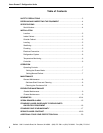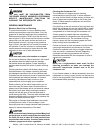
8
Versa Drawer™ Refrigeration Units
Deleld · 980 S. Isabella Road, Mt. Pleasant, MI 48858 · (989) 773-7981 or (800) 733-8829 · Fax (989) 773-3210
THE UNIT MUST BE DISCONNECTED FROM
THE POWER SOURCE WHENEVER PERFORMING
SERVICE, MAINTENANCE FUNCTIONS OR
CLEANING THE REFRIGERATED AREA.
GENERAL MAINTENANCE
Stainless Steel Care and Cleaning
To prevent discoloration or rust on stainless steel
several important steps need to be taken. First, the
properties of stainless steel need to be understood.
Stainless steel contains 70-80% iron that will rust. It
also contains 12-30% chromium that forms an invisible
passive lm over the steel’s surface and acts as a
shield against corrosion. As long as the protective
layer is intact, the metal will not corrode, the metal is
still stainless. If the lm is broken or contaminated,
outside elements can begin to break down the steel
and begin to form rust or other discoloration.
Never use steel pads, wire brushes or scrapers!
Do not use an abrasive cleaner because it will scratch
the stainless steel and plastic and can damage
the breaker strips and gaskets. Proper cleaning of
stainless steel requires soft cloths or plastic scouring
pads.
Cleaning solutions need to be alkaline based or non-
chloride cleaners. Any cleaner containing chlorides
will damage the protective lm of the stainless steel.
Chlorides are also commonly found in hard water, salts
and household and industrial cleaners. If cleaners
containing chlorides are used, be sure to rinse
repeatedly and dry thoroughly upon completion.
Routine cleaning of the interior and exterior can be
done with soap and warm water. Extreme stains or
grease should be cleaned with a non-abrasive cleaner
and plastic scrub pad. When cleaning the exterior,
always rub with the grain of the stainless steel to
avoid marring the nish. There are also stainless steel
cleaners available which can restore and preserve the
nish of the steels protective layer.
Early signs of stainless steel breakdown can consist
of small pits and cracks. If this has begun, clean
thoroughly and start to apply stainless steel cleaners in
attempt to restore the passivity of the steel.
Never use an acid based cleaning solution! Many food
products have an acidic content that can deteriorate
the nish. Be sure to clean ALL food products from
any stainless steel surface. Common items include,
tomatoes, peppers and other vegetables.
Cleaning the Condenser Coil
The condenser coil requires regular cleaning,
recommended is every 90 days. In some instances
you may nd that there is a large amount of debris and
dust or grease accumulated prior to the 90-day time
frame. In these cases the condenser coil should be
cleaned as needed.
If the build up on the coil consists of only light dust and
debris the condenser coil can be cleaned with a simple
brush. Heavier dust build up may require a vacuum or
compressed air to blow through the condenser coil.
If heavy grease is present there are de-greasing
agents available for refrigeration use and specically
for the condenser coils. The condenser coil may
require a spray with the de-greasing agent and then
blown through with compressed air.
Failure to maintain a clean condenser coil can initially
cause high temperatures and excessive run times.
Continuous operation with dirty or clogged condenser
coils can result in compressor failures. Neglecting
condenser coil cleaning procedures will void any
warranties associated with the compressor or cost to
replace the compressor.
Never use a high-pressure water wash for this
cleaning procedure as water can damage the
electrical components located near or at the
condenser coil.
If your freezer seems to vibrate excessively when the
compressor is running, loosen (but do not remove) the
bolts on the compressor. Semi hermetic models should
be loosened before operating.


















